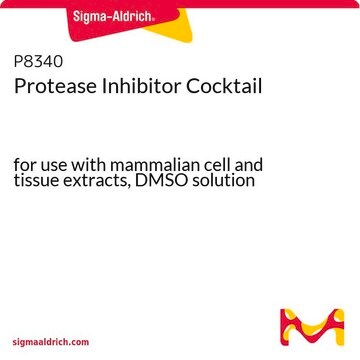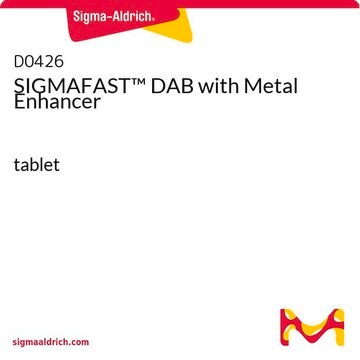This product has a shelf life of 3 years.
D5637
3,3′-Diaminobencidina tetrahydrochloride hydrate
≥96%
Sinónimos:
(1,1′-bifenil)-3,3′,4,4′-tetramina tetrahidrocloruro dihidrato
Seleccione un Tamaño
$46.93
Precio de catálogo$49.50Ahorre 5 %Disponible para envío el02 de abril de 2025Detalles
Seleccione un Tamaño
About This Item
$46.93
Precio de catálogo$49.50Ahorre 5 %Disponible para envío el02 de abril de 2025Detalles
Productos recomendados
Nivel de calidad
Ensayo
≥96%
Formulario
powder, crystals or chunks
técnicas
titration: 96-104% (with NaOH)
color
white to light brown, and Faint Red and Faint Grey to Light Grey
mp
280 °C
solubilidad
H2O: 50 mg/mL
aplicaciones
diagnostic assay manufacturing
hematology
histology
temp. de almacenamiento
−20°C
cadena SMILES
O.Cl.Cl.Cl.Cl.Nc1ccc(cc1N)-c2ccc(N)c(N)c2
InChI
1S/C12H14N4.4ClH.H2O/c13-9-3-1-7(5-11(9)15)8-2-4-10(14)12(16)6-8;;;;;/h1-6H,13-16H2;4*1H;1H2
Clave InChI
DXWSCXIZIHILNP-UHFFFAOYSA-N
¿Está buscando productos similares? Visita Guía de comparación de productos
Categorías relacionadas
Descripción general
Aplicación
Acciones bioquímicas o fisiológicas
Palabra de señalización
Danger
Frases de peligro
Consejos de prudencia
Clasificaciones de peligro
Acute Tox. 4 Oral - Carc. 1B - Eye Irrit. 2 - Muta. 2
Código de clase de almacenamiento
6.1C - Combustible acute toxic Cat.3 / toxic compounds or compounds which causing chronic effects
Clase de riesgo para el agua (WGK)
WGK 3
Punto de inflamabilidad (°F)
Not applicable
Punto de inflamabilidad (°C)
Not applicable
Equipo de protección personal
Eyeshields, Gloves, type N95 (US)
Elija entre una de las versiones más recientes:
¿Ya tiene este producto?
Encuentre la documentación para los productos que ha comprado recientemente en la Biblioteca de documentos.
Los clientes también vieron
Artículos
NBT-BCIP substrate system aids in western blotting and immunohistological staining, producing a blue-purple insoluble end product.
-
What is the shelf life of Product D5637, 3,3´-Diaminobenzidine tetrahydrochloride hydrate (DAB)?
1 answer-
Helpful?
-
-
Do you have a staining protocol for Product D5637, 3,3´-Diaminobenzidine tetrahydrochloride hydrate (DAB)?
1 answer-
Dissolve 10 mg in 15 mL of Tris buffered saline, pH 7.6 (Tris-buffered saline tablet, Sigma Product No. T5030 may be used). Add 12 uL of fresh 30% hydrogen peroxide (Sigma Product No. H1009) prior to use. Solution may be filtered through a 0.2 micron filter immediately prior to use if necessary. DAB and hydrogen peroxide concentrations may be adjusted to suit individual applications. The stain can be enhanced with Ni. Make up 0.3% (w/v) NiCl2 in water. Add 1 mL of the NiCl2 stock to 9 mL DAB solution.
Helpful?
-
-
What is the Department of Transportation shipping information for this product?
1 answer-
Transportation information can be found in Section 14 of the product's (M)SDS.To access the shipping information for this material, use the link on the product detail page for the product.
Helpful?
-
-
Can the solutions of Product D5637, 3,3´-Diaminobenzidine tetrahydrochloride hydrate (DAB), be filtered?
1 answer-
DAB solution may be filtered through a 0.2 micron filter immediately prior to use.
Helpful?
-
-
What is the solution stability of Product D5637, 3,3´-Diaminobenzidine tetrahydrochloride hydrate (DAB)?
1 answer-
In our experience, solutions of DAB should be made immediately prior to use for best results. If and only if necessary, solutions can be kept in the dark and refrigerated for overnight storage. Based on our Immunology Department’s experience, storing the solution overnight did not give good reproducibility. However, the literature indicates that it is possible to store solutions of DAB at -20°C. DAB dissolved in Tris buffered saline (pH 7.6) at 0.6 mg/ml was reported to be stable for several weeks at 4°C.
Helpful?
-
-
What is Product D5637, 3,3´-Diaminobenzidine tetrahydrochloride hydrate (DAB), soluble in?
1 answer-
DAB HCl is soluble in water at 50 mg/ml yielding a clear to slightly hazy solution. For consistency, it is important to allow DAB to come to room temperature before making solutions. Water quality is extremely important, so only high quality deionized or distilled water should be used to make DAB solutions.
Helpful?
-
-
How is Product D5637, 3,3´-Diaminobenzidine tetrahydrochloride hydrate (DAB), shipped and stored?
1 answer-
The product is shipped at ambient temperature. However, it is stored at -20 degrees C for long term storage.
Helpful?
-
Active Filters
Nuestro equipo de científicos tiene experiencia en todas las áreas de investigación: Ciencias de la vida, Ciencia de los materiales, Síntesis química, Cromatografía, Analítica y muchas otras.
Póngase en contacto con el Servicio técnico










